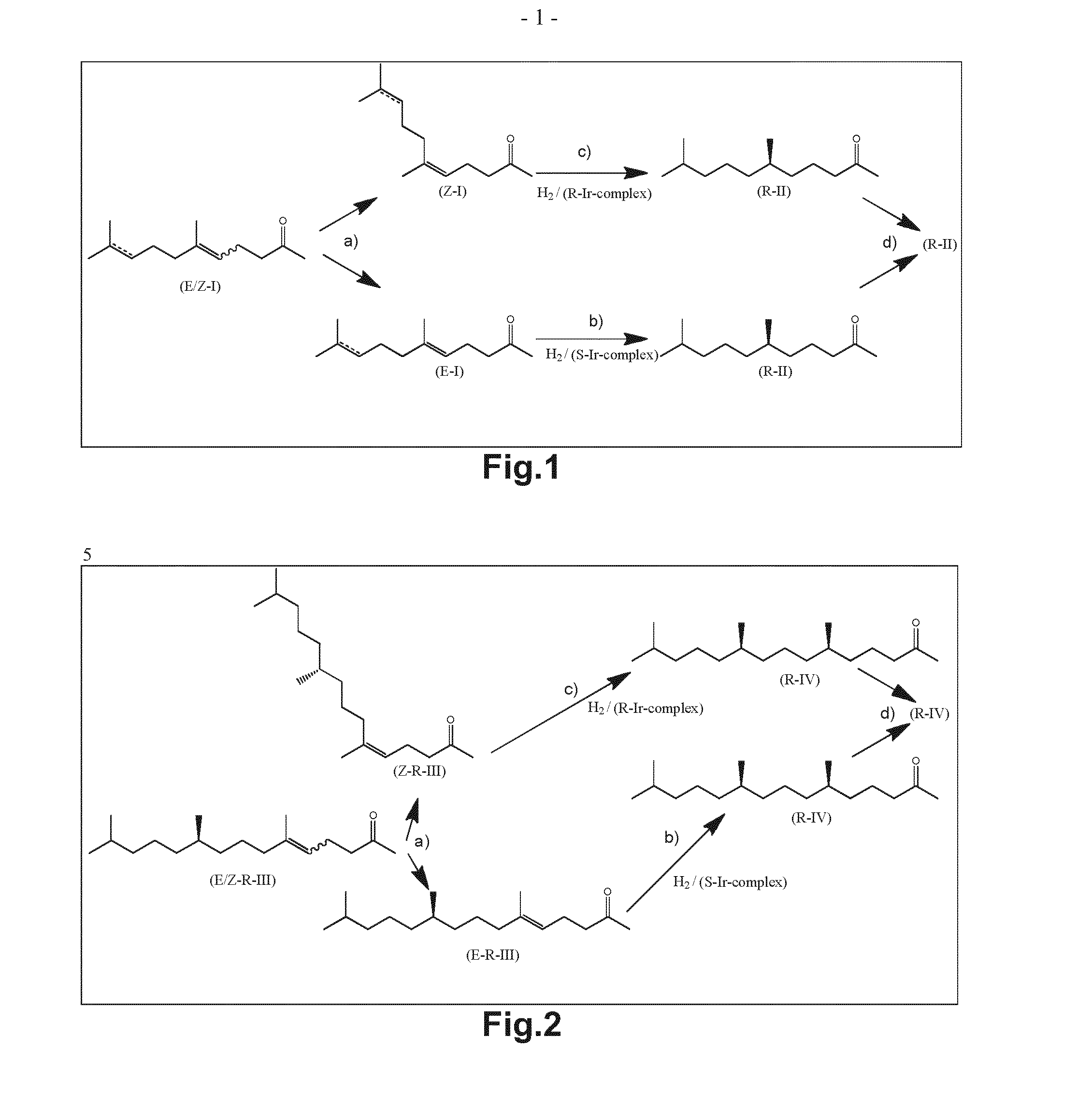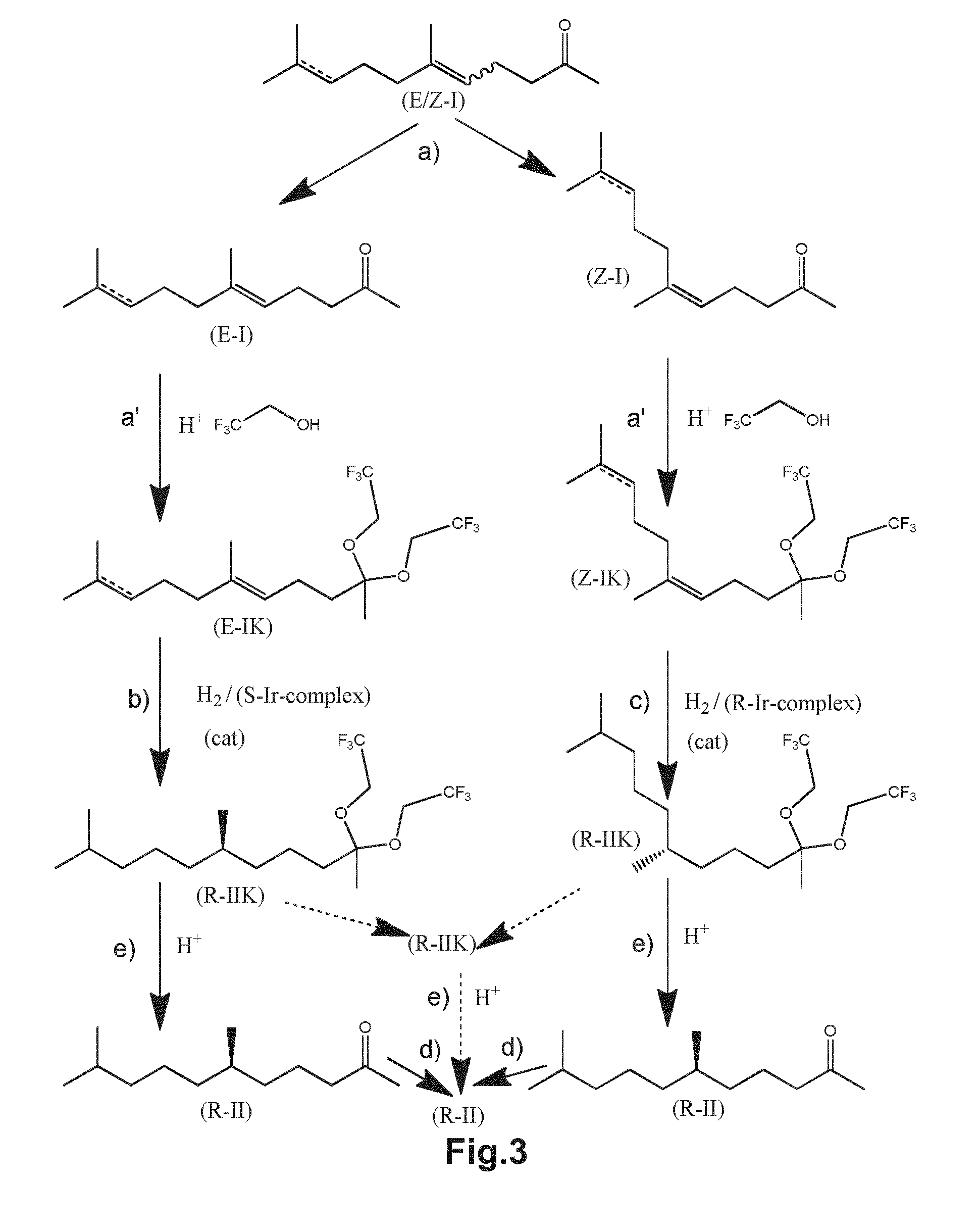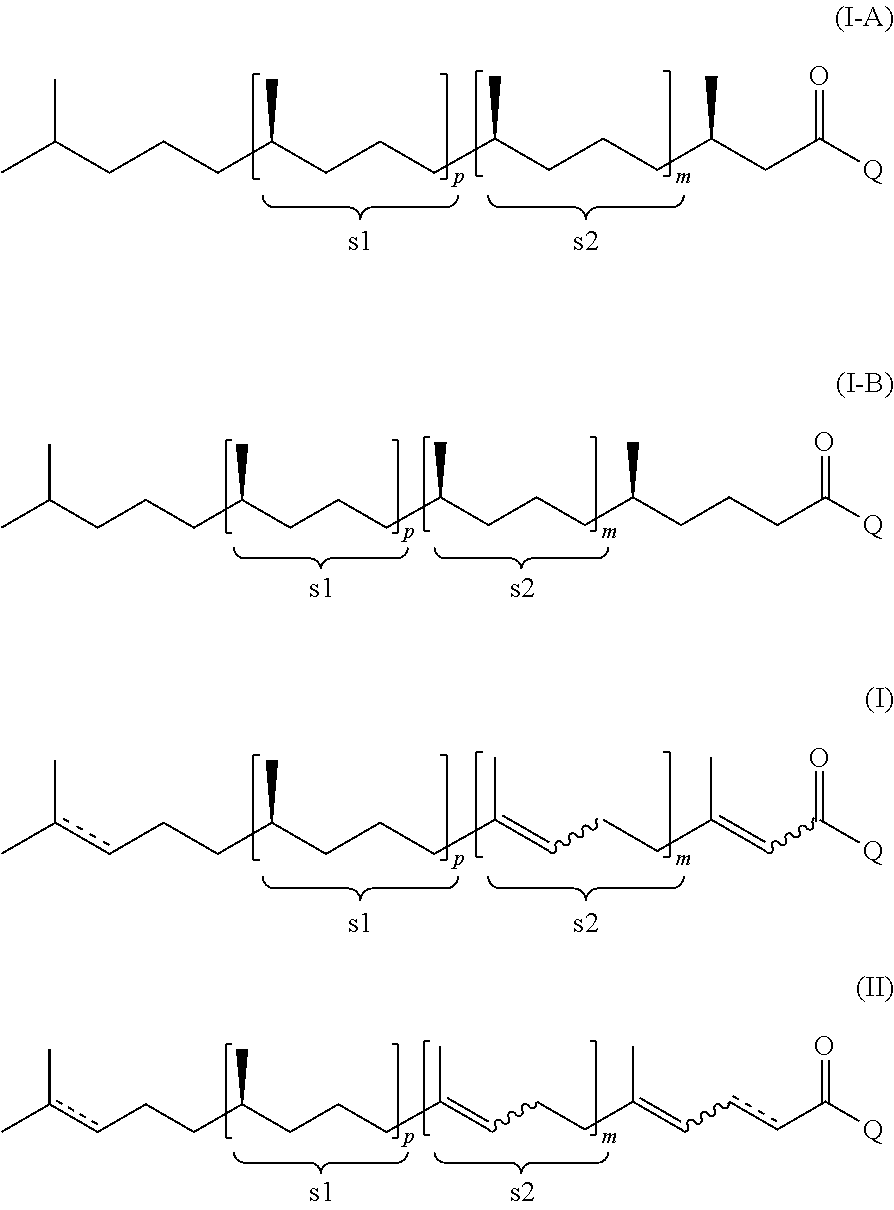Using mixtures of e/z isomers to obtain quantitatively specific products by combined asymmetric hydrogenations
a technology of e/z isomers and mixtures, which is applied in the field of asymmetric hydrogenation and the synthesis of chiral ketones, aldehydes, acetals and ketals, can solve the problems of expensive separation processes and achieve the effect of improving the efficiency of chiral complexes
- Summary
- Abstract
- Description
- Claims
- Application Information
AI Technical Summary
Benefits of technology
Problems solved by technology
Method used
Image
Examples
examples
[0173]The present invention is further illustrated by the following experiments.
Analytical Methods
GC Determination of E / Z-ratio and / or purity of 6,10-dimethylundec-5-en-2-one (DHGA), (R)-6,10-dimethylundecan-2-one (THGA) and (R)-6,10,14-trimethylpentadec-5-en-2-one (R-THFA)
[0174]Agilent 6850, column DB-5HT (30 m, 0.25 mm diameter, 0.10 μm film thickness), 107 kPa helium carrier gas). The samples were injected as solutions in hexane, split ratio 300:1, injector temperature 200° C., detector temperature 350° C. Oven temperature program: 100° C. (8 min), 10° C. / min to 200° C. (1 min), 20° C. / min to 220° C. (4 min), runtime 24 min.
GC Determination of purity of (6R,10R)-6,10,14-trimethylpentadecan-2-one
[0175]Agilent 6850, column DB-5HT (30 m, 0.25 mm diameter, 0.10 μm film thickness), 115 kPa helium carrier gas). The samples were injected as solutions in hexane, split ratio 300:1, injector temperature 200° C., detector temperature 350° C. Oven temperature program: 120° C. (5 min), 14° C....
experiment e1-1
Separation of E / Z isomer mixtures of 6,10-dimethylundec-5-en-2-one (step a)
[0186]7.02 kg of 6,10-dimethylundec-5-en-2-one was prepared according to example 10 of DE 1 193 490 and was analysed by the GC method given above to be a 57% / 43% mixture of (E)-6,10-dimethylundec-5-en-2-one and (Z)-6,10-dimethylundec-5-en-2-one (99% purity).
[0187]The mixture was distilled using separation equipment consisting of a still (volume: 9 litre) with a falling film evaporator, a rectifying column (70 mm inner diameter, height 5 m). The column was equipped with a very efficient structured packing (Sulzer). The mixture was rectified at a top pressure of approx. 5 mbar and at a column top temperature in the range from 105 to 112° C. and a bottom temperature in the still of about 125° C. The reflux ratio was adjusted to 20.
[0188]Fractions containing (Z)-6,10-dimethylundec-5-en-2-one (content of Z-isomer=99%, E-isomer <1%) as well as fractions containing (E)-6,10-dimethylundec-5-en-2-one (content of E-iso...
experiment e1-2
Asymmetric hydrogenations of 6,10-dimethylundec-5-en-2-one (step b / c)
[0189]Both isomers (E)-6,10-dimethylundec-5-en-2-one (“E-DHGA”) (E / Z=99.5 / 0.5) and (Z)-6,10-dimethylundec-5-en-2-one (“Z-DHGA”) (Z / E=99 / 1) were hydrogenated asymmetrically, separate from each other in the following manner:
[0190]A 2 L autoclave was charged with 70 g (0.353 mol) of the specific isomer, 700 mL of 2,2,2-trifluoroethanol and a solution of the chiral iridium complex of formula (III-F) having the chirality given in table 1 at the centre indicated by * in said formula (570 mg, 0.356 mmol, 0.1 mol %) in anhydrous dichloromethane (10 g). The autoclave was closed and a pressure of 50 bar of molecular hydrogen was applied. The reaction mixture was heated to 30° C. whilst stirring for 2 hours. Afterwards the pressure was released and the solvent was removed. The product formed is (R)-6,10-dimethylundecan-2-one. The conversion as well as the amount of isomers formed is determined as indicated above and the resul...
PUM
 Login to View More
Login to View More Abstract
Description
Claims
Application Information
 Login to View More
Login to View More - R&D
- Intellectual Property
- Life Sciences
- Materials
- Tech Scout
- Unparalleled Data Quality
- Higher Quality Content
- 60% Fewer Hallucinations
Browse by: Latest US Patents, China's latest patents, Technical Efficacy Thesaurus, Application Domain, Technology Topic, Popular Technical Reports.
© 2025 PatSnap. All rights reserved.Legal|Privacy policy|Modern Slavery Act Transparency Statement|Sitemap|About US| Contact US: help@patsnap.com



